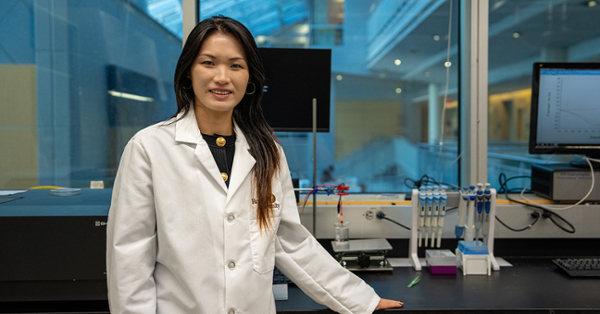NSF backs research on low-cost sensor to detect PFAS in water
NSF backs research on low-cost sensor to detect PFAS in water

Per- and polyfluoroalkyl substances (PFAS), a class of highly stable artificial chemicals known for their resistance to natural degradation, continue to be detected in municipal water supplies. Because of the known health hazards of PFAS, accurately measuring their levels is critical for public health and environmental safety. However, traditional methods are time-consuming, expensive and require special training.
Dongmei Dong, Ph.D., assistant professor in the Department of Physics & Astronomy in the College of Science and Mathematics, has received a two-year, $200,000 grant from the National Science Foundation to develop a less expensive, portable and easier-to-use alternative to detect even trace levels of PFAS. Her lab’s interdisciplinary solution borrows from chemistry, electrical engineering, and materials science. The basic idea is that PFAS in the water interacts with the sensor material to produce an easily measurable output.
Dong’s team is developing a new sensing system designed to quantify PFAS contamination in water through a simple, real-time electronic response. The device produces easy-to-interpret results, enabling rapid and reliable on-site monitoring.
The sensor material allows users to confirm results through multiple detection cues when it comes into contact with PFAS. Such a unique design, especially at extremely low concentrations, makes the sensor even more accurate. The lower cost—around $100, compared to traditional methods that can run into the millions—is another key advantage.
Equally important, the underlying physics in the detection of PFAS can be applied to monitor other chemicals with only minor modifications to the sensor, Dong said.
Trained in materials science and condensed matter physics, Dong has poured years of work into electrochromic materials and this measurement module. Prior experience in transistor-based sensors, which she used for hydrogen fuel cell membrane diagnostics, has also proven useful.
Dong has ambitious goals for the research, including to use the project to nurture interest in science, technology, engineering, art and mathematics (STEAM). Both high school and college students contribute to the project which will help expand outreach efforts such as Rowan’s STEAM Academy for high school students. These programs encourage young scholars to explore interdisciplinary research in physics, materials and environmental science. Findings will be incorporated into physics courses to help students connect theory with real-world applications.
In addition, communities in southern New Jersey will benefit from this work through public engagement initiatives such as lab open houses and Earth Day events. The overarching goals, in addition to the facilitation of convenient PFAS testing, are to raise awareness about the risks and to empower individuals with knowledge about water quality and chemical sensing.